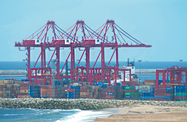Infrastructure investment and more diversified freight-handling services are expected to help Sri Lanka move towards its goal of becoming a major logistics hub, even as the country faces significant competition from within the region.

In late August Mahinda Samarasinghe, the minister for ports and shipping, announced plans were being finalised to expand the Port of Colombo’s East Container Terminal (ECT), one of five terminals at the site.
Under the project, expected to launch before the end of the year, the ECT will have a 1200-metre quay wall, three berthing facilities with a depth of 18 sq metres and a container yard with an annual capacity of 2.4m twenty-foot equivalent units (TEUs). At present, the ECT has restricted freight-movement capacity, with limited berthing space and container-loading and unloading equipment.
The expansion will allow the terminal to receive large container ships and potentially diversify beyond trans-shipment activities, with the project to be managed by the state’s Sri Lanka Ports Authority (SLPA).
Construction progress is being accelerated through the short-term leasing of freight-moving equipment such as gantry and mobile cranes, helping to bring the enhanced facility on-line quicker, according to industry officials.
Port of Colombo records strong freight-handling growth
The expansion of cargo-handling capacity comes amid an increase in activity, with the Port of Colombo ranked first globally in terms of throughput growth in the first half of the year, according to a report issued by maritime analytics firm Alphaliner.
Container movements were up 15.6% year-on-year at 3.4m TEUs, making the Port of Colombo one of just three ports – along with Singapore and Jakarta – to post double-digit growth during the first six months of the year. The result saw Colombo move up one spot to 22nd in the rankings of overall throughput, with the port on track to surpass its 2017 record of 6.2m TEUs in container movements.
Despite continued strong growth, there is a high level of regional competition in maritime logistics. According to the Alphaliner report, 15 of the top-21 ports by throughput are located in Asia. Additionally, some of the top operators have especially sizeable operations by comparison; for example, Colombo’s total TEU movements between January and the end of June were less than 20% of world-leading ports in Shanghai and Singapore.
On the matter of capacity, in light of rising freight-handling activity, Sri Lanka’s port operators have developed a strategy to ease congestion and maintain smooth throughput.
Under an agreement between the Port of Colombo’s three main terminal operators – South Asia Gateway Terminal, Jaya Container Terminal and Colombo International Container Terminal – if one company’s berths are full, a carrier can be transferred to the terminal of another operator to be handled, enhancing the efficiency of the port.
Diversification to boost maritime offerings
In addition to hard infrastructure and cooperative agreements, Sri Lanka is aiming to improve its maritime position by diversifying its services.
Local media reported in early September that government officials were finalising reforms to facilitate less-than-container load (LCL) trade, a form of shipping where cargo from different origins or freighters can be combined in a single container to save on costs, time and logistics operations. In particular, it can make shipping more viable for smaller businesses or companies looking to move lighter freight volumes in a cost-effective manner.
At present, Sri Lanka only allows limited multi-country consolidation (MCC) trade, primarily through the SLPA, but the proposed reforms would liberalise the MCC regulations, allowing more players to get involved and increasing LCL activity.
Given Sri Lanka’s strategic location between East Asia and the Middle East, industry figures have also highlighted maritime services such as bunkering – the act of supplying ships with fuel – as a target area with strong growth potential.
“Trans-shipment has been the main driver of growth across the sector, but Sri Lanka has far more potential, especially in value-added services such as bunkering,” Rohan De Silva, chairman and managing director of the McLarens Group, a shipping, logistics and marine services conglomerate, told OBG.
He added that with further development, the Port of Hambantota in the country’s south, with its potential to host a tank farm, could increase competitiveness in bunkering services, though port ancillary services across the board would need to be improved to achieve this.


